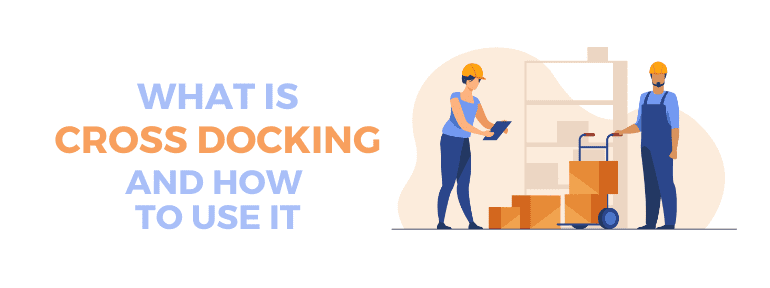Surely many of you are wondering what is cross docking? In this post I want to explain this concept as well as its main features, advantages and disadvantages.
Cross docking is a logistics tool or technique, which aims to promote cost savings, an increase in product quality and a decrease in delivery times. This greatly helps to improve or optimize logistics processes, and consequently is a way to increase customer satisfaction.
More specifically, cross docking is based on a logistics technique of order picking, with the characteristic that no intermediate storage of the goods is necessary.
In other words, there is no or very limited intermediate storage of the goods beforehand. It consists of quickly taking an unloaded product from an inbound transport to an outbound vehicle, so that the goods are received and loaded practically at the same time.
Table of contents
How do cross docking operations work?
The mechanics of the logistics process aren’t that complicated. First of all, it’s necessary to place not one but two transport vehicles and dock doors, these will serve as entry and exit, which makes it possible to move the goods in an agile and fast way and without the need to store them.
As we can see, this is a traditional supply chain, in which the warehouse represents a fundamental part, since it connects suppliers (supply) with consumers (demand).
Since supply and demand aren’t always fully synchronized, the link is the warehouse, since this is where the goods are stored until demand is activated.
It’s in this context where cross docking works, since as we’ve seen, for the success of this methodology it’s necessary and fundamental the perfect coordination of all the actors involved, namely: suppliers, warehousemen, transporters and end users.
As a consequence, there’ll be a streamlining of the process and cost reduction, since it greatly shortens delivery times and optimizes the performance of the resources used, which improves the customer experience.
If we pay attention, we’ll see that cross docking doesn’t use two of the most common activities in any normal logistics chain: the inventory or placement of goods in stock and the picking process or the preparation of orders.
Phases of cross docking

In a somewhat general or simplified way, the fundamental phases of cross docking that we always have to take into account are the following:
- Scheduling of supplier distribution
- Reception of the goods in the warehouse
- Review of the goods received in the quality control process
- Packing and consolidation or dispatch of the goods
Types of cross docking
There are different types of cross docking to be carried out, depending on the loading units, such as boxes, kits or pallets. If we focus on the steps required to perform it, we can classified them in three:
Direct or pre-distributed cross docking
Pre-distributed is identified with the most basic model of cross docking. It’s usually used with products that have a high turnover and reduced dimensions.
In this model, the loading units are previously separated and properly organized by the supplier, taking into account the final demand. In this case, the handling is minimal, since the goods are separated and properly prepared to be dispatched as quickly as possible to the destination.
Indirect or consolidated cross docking
In this model of cross docking, it’s necessary for the goods to be handled in a way that adapts to the requirements of the end customer.
In indirect cross docking, a separation and relabeling stage is included before being sent, in order to organize the goods. Once the goods are received, they’re moved to a cross-docking area or conditioning area, where they’re examined and adjusted to the demanded orders.
This may involve arranging pallets from smaller unit loads or the reverse: splitting the goods into individual packages or product kits.
Hybrid cross docking
This is the most complex type of cross-docking, since it involves the preparation of goods in the conditioning area, with the peculiarity that it handles both, the goods coming from the incoming trucks and those that were previously stored in the installation.
In this type of case, the goods received have two options: they can go directly to the aforementioned temporary storage area or directly to the cross docking process.
In this way, the cross docking model is more flexible, as it gives you the possibility to deal with a wider variety of situations. But at the same time, an efficient coordination of all tasks that are related to this operation is absolutely necessary.
Cross docking is already used by many companies, due to the need to meet the needs of a single-channel supply chain.
However, before applying it to our order picking strategies, it’s important to know the advantages and disadvantages of cross docking, which we’ll see below. So we can evaluate more efficiently the suitability of this model for our company.
Main advantages of cross docking

- Less handling of the products. The unloading, quality control, packaging of orders and dispatch of goods is maintained. But intermediate stages such as storage or picking, disappear.
By reducing the handling of materials that may intervene in the process, possible errors are reduced.
- Delivery times are shortened. This type of logistics strategy allows you to have greater control of deadlines, simplifying the traditional process, so that the forecast of deliveries at different points of sale is greatly improved. In addition to a better customer service.
- Costs are reduced. First of all, because large storage spaces are not needed. And the processes of selection, location and preparation of orders (picking) are eliminated.
At the same time, it allows us to unify the goods, as long as they have similar weights and their delivery is destined to places close to each other, so that we can reduce the cost associated with their distribution.
- It’s a more sustainable system, as it reduces the carbon footprint of the supply chain. This is directly related to the transportation of goods.
Cross docking allows energy savings both inside and outside the warehouse, making it possible to run a greener and more environmentally friendly supply chain.
- High product turnover. Goods are moved quickly, they don’t usually spend more than 24 hours in the warehouse, so they have a longer shelf life.
Risks or disadvantages of cross docking
- It implies a high initial investment to start it up, due to the fact that a redesign of the warehouse or a new configuration of the warehouse system is necessary to allow a cross docking model.
- Great coordination and administrative planning, so that all the factors involved in the loads go directly to the reception and in a synchronized way.
- Effective integration of the entire supply chain. For example, the labelling system, as well as all the information systems, must be common to the different agents involved, in order to speed up the process.
- Danger of bottleneck. If any complication appears in the synchronization of the supply chain, it can lead to economic losses for the company.
Conclusions
As we’ve seen, incorporating a cross docking model in the supply chain, and its correct implementation, can bring great advantages.
In any case, there are many challenges or obstacles to overcome in the final journey that takes the product to the end customer. Factors such as meeting delivery deadlines, meeting customer expectations, the growing concern for the environment… But the cross docking model is a good alternative to solve all these factors.
This system, which aims to use the warehouse as little as possible, has positioned itself as an ideal option to improve the overall profitability of warehouses and even as a competitive advantage for companies that implement it.
Related Posts










Deja un comentario